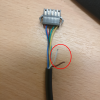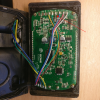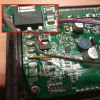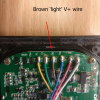HI all,
Apologies if this is dealt with elsewhere.
After replacing a failed controller (with one that was promised to be SW900-compatible, but really isn't), I decided to wire in the lights to the (battery voltage) 'lights' output of the controller, through a 48V->12V DC-DC converter. Predictably, the lights are on whenever the controller is on, instead of being switchable by the UP-arrow.
Since a lot of these LCDs have the extra 'LIGHTS' connector with the brown and white wires, I wanted to look into how to use them. Since the manuals offer no help, I thought I'd ask here before trying to figure it out with a voltmeter. So, the questions are:
1. Is the voltage regulated, and does it have a cut-off?
2. Is the current regulated and how much can safely be drawn (looks like at least a couple of amps - see below)?
3. Is it best to just use the voltage through a divider to switch a relay?
4. Does anyone have a bike that has this wired up and can provide a wiring diagram?
I opened up an old SW900 (pic below). From the transistor data sheet, it looks like it can take a decent load, but I don't know how much it would take without cooling. At the moment, I think the LCD light cable can power a 15W LED headlight. The battery voltage across those wires would be about 50V max, so the current would be 15/50 = 300 mA. The rear flashing light can be on with the controller (maybe through a 555 timer if I can't find a flashing red light. Does anyone concur?
Anyway, here are some pics, including an opened SW900 that had water damage. Interestingly, one of the vendors has a lamp just wired directly without further comment, but I wouldn't necessarily trust that.










I think this is worth figuring out, since so many kits use these LCDs.
Thanks,
Bob
Apologies if this is dealt with elsewhere.
After replacing a failed controller (with one that was promised to be SW900-compatible, but really isn't), I decided to wire in the lights to the (battery voltage) 'lights' output of the controller, through a 48V->12V DC-DC converter. Predictably, the lights are on whenever the controller is on, instead of being switchable by the UP-arrow.
Since a lot of these LCDs have the extra 'LIGHTS' connector with the brown and white wires, I wanted to look into how to use them. Since the manuals offer no help, I thought I'd ask here before trying to figure it out with a voltmeter. So, the questions are:
1. Is the voltage regulated, and does it have a cut-off?
2. Is the current regulated and how much can safely be drawn (looks like at least a couple of amps - see below)?
3. Is it best to just use the voltage through a divider to switch a relay?
4. Does anyone have a bike that has this wired up and can provide a wiring diagram?
I opened up an old SW900 (pic below). From the transistor data sheet, it looks like it can take a decent load, but I don't know how much it would take without cooling. At the moment, I think the LCD light cable can power a 15W LED headlight. The battery voltage across those wires would be about 50V max, so the current would be 15/50 = 300 mA. The rear flashing light can be on with the controller (maybe through a 555 timer if I can't find a flashing red light. Does anyone concur?
Anyway, here are some pics, including an opened SW900 that had water damage. Interestingly, one of the vendors has a lamp just wired directly without further comment, but I wouldn't necessarily trust that.










I think this is worth figuring out, since so many kits use these LCDs.
Thanks,
Bob





